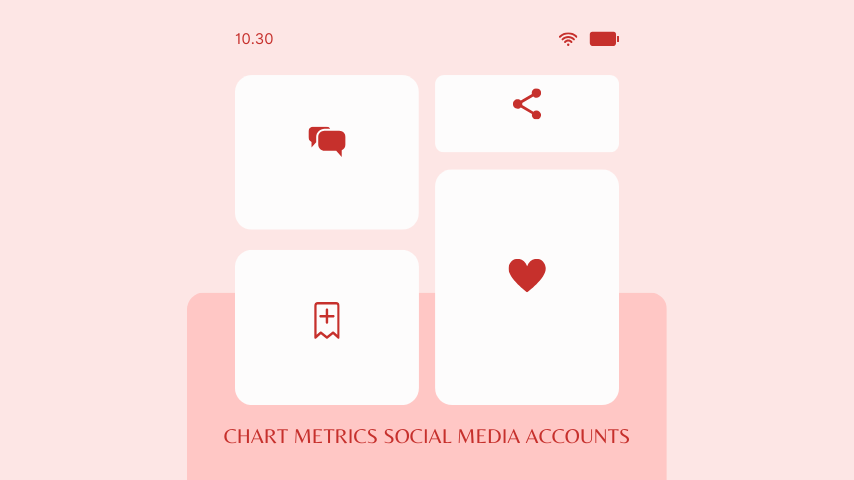
In the world of social media, data is power. But how do you unlock that power? By analyzing the metrics that matter. Whether you’re running a small business or managing a large brand, understanding your social media performance is key to optimizing your strategy and achieving your goals.
1. Set Clear Goals Before You Analyze
Before jumping into numbers, you need to understand why you’re tracking social media metrics in the first place. What are you trying to achieve? Is it brand awareness, lead generation, or customer engagement? Your goals will dictate which metrics are most important for you.
Common social media goals:
Increase Brand Awareness: Reach, Impressions, and Followers.
Boost Engagement: Likes, Comments, Shares, and Click-through Rates (CTR).
Drive Traffic: Website clicks, referral traffic, and bounce rate.
Generate Leads: Form submissions, sign-ups, and conversions.
When your goals are clear, you can better focus on the data that truly impacts your success.
2. Reach and Impressions: Are You Getting Noticed?
Two of the most fundamental metrics to track are Reach and Impressions. Though often used interchangeably, they provide different insights into how your content is performing.
Reach measures how many unique users have seen your post.
Impressions track how many times your content has been displayed, whether it was clicked or not.
Why these metrics matter:
Reach gives you an understanding of how many people your content is reaching, helping you gauge the size of your audience.
Impressions provide insight into how often your content is being shown, which is useful for understanding visibility and content effectiveness.
By tracking both metrics, you can gauge how far your content is traveling and whether your content is making an impact.
3. Engagement Rate: The Heart of Interaction
Engagement is a critical metric for understanding how your audience interacts with your content. It goes beyond just likes and shares—it’s about building a relationship with your followers. Engagement rate is typically calculated as:
(Total Engagements / Total Followers) * 100
Engagements include likes, comments, shares, saves, and any other actions your audience takes.
Why it matters:
High engagement indicates that your audience finds your content valuable, interesting, or entertaining.
Low engagement could signal that your content isn’t resonating or that you’re not posting consistently enough to stay top-of-mind.
Look for trends in what kinds of posts generate the most engagement, and use that information to optimize your content.
4. Click-Through Rate (CTR): Driving Action
The Click-Through Rate (CTR) measures how often people click on links in your posts, ads, or bio. It’s a vital metric for understanding if your audience is moving beyond just viewing your posts to take action, such as visiting your website or checking out your products.
CTR = (Total Clicks / Total Impressions) * 100
Why it matters:
High CTR suggests your content is compelling enough to get people to take action.
Low CTR indicates that your call-to-action (CTA) may need to be more appealing, or your audience may not find the link valuable.
To improve CTR, experiment with different CTAs, imagery, and messaging that encourages people to click.

5. Conversion Rate: From Engagement to Outcome
Ultimately, conversions are often the end goal of your social media marketing efforts. Whether it’s signing up for a newsletter, making a purchase, or downloading an e-book, tracking your conversion rate shows how well your social media efforts are translating into actual business results.
Conversion Rate = (Conversions / Total Clicks) * 100
Why it matters:
High conversion rates mean that your social media strategy is effectively moving people through your funnel, turning them into customers or leads.
Low conversion rates could mean you need to refine your landing pages, improve your offer, or optimize your social posts to better align with what your audience wants.
6. Follower Growth Rate: Are You Building an Audience?
The rate at which your follower count increases is a useful indicator of your brand’s growth and the appeal of your social media presence. However, follower count alone doesn’t provide enough context—what matters is how fast you’re gaining followers and whether that growth is consistent.
Follower Growth Rate = (New Followers / Starting Followers) * 100
Why it matters:
A steady growth rate indicates that your content is resonating and that more people are discovering your brand.
Sudden spikes may be due to a viral post, but they don’t always indicate sustainable growth.
Monitoring your follower growth rate alongside other metrics helps you understand whether your audience is truly expanding, or if your numbers are just fluctuating.
7. Audience Demographics: Who Are You Reaching?
It’s not just about how many people see your posts—it’s about who sees them. Understanding your audience demographics (age, gender, location, interests, etc.) helps you ensure you’re targeting the right people with your content.
Why it matters:
Knowing your audience ensures you can tailor your content to their preferences and interests.
Analyzing demographic data can help you identify any gaps in your target audience and refine your marketing strategy.
Platforms like Instagram, Facebook, and Twitter offer insights into the age, gender, and location of your followers, giving you a clear picture of who you’re reaching.
8. Track Social Shares: How Far Is Your Content Spreading?
Shares are one of the most powerful metrics because they show that people find your content worthy of passing along to others. When followers share your posts, it increases your reach exponentially.
Why it matters:
More shares indicate that your content is resonating deeply with your audience, potentially expanding your audience as it reaches friends, family, and colleagues.
Few shares might suggest that your content isn’t striking the right emotional or informational chord with your audience.
Creating share-worthy content often means providing value, telling a compelling story, or offering something unique.
9. Use Data to Optimize Your Strategy
Once you’ve gathered all your data, the key to success is optimizing your strategy based on the insights you gain. If certain posts perform better than others, analyze why that is—was it the visuals, the timing, or the messaging? Use this information to replicate what works and discard what doesn’t.
Optimization tips:
Test different content types: If videos are getting more engagement than static posts, create more video content.
Experiment with posting times: Post when your audience is most active, based on platform insights.
Tweak your CTAs: If your CTR is low, test new calls-to-action or link placements.
Social media success isn’t just about posting content—it’s about continually refining your approach based on the data.
Final Thoughts
Social media metrics provide you with the feedback you need to improve your performance, but they only work if you’re actively using the data to refine your strategy. By tracking key metrics like engagement rate, CTR, conversion rate, and audience demographics, you’ll get a clearer picture of what’s working—and what isn’t.
The next time you review your social media analytics, focus not only on the numbers but also on what the data is telling you about your audience and your content. With a data-driven approach, you can continuously optimize your social media efforts and improve your overall performance.


